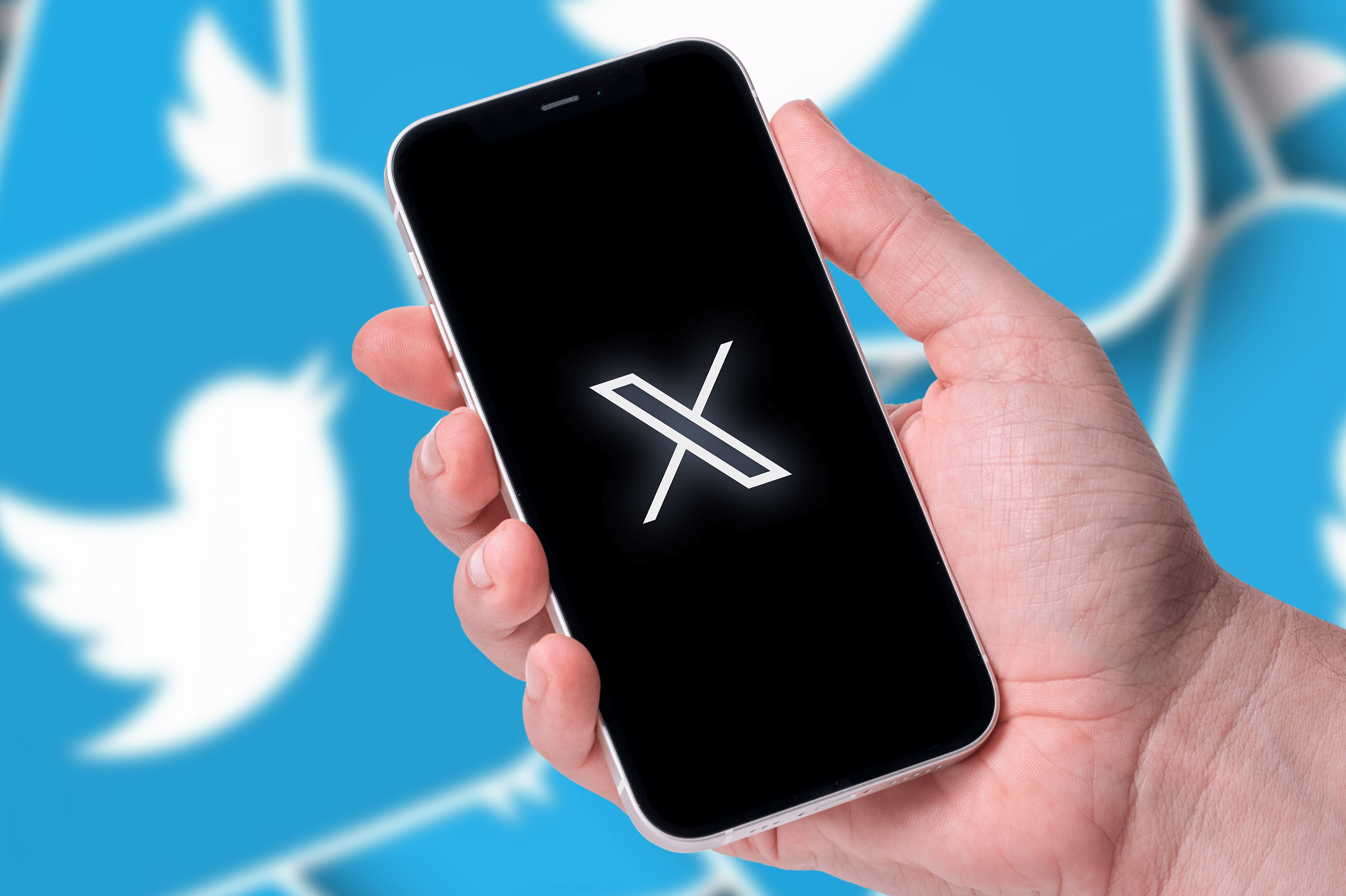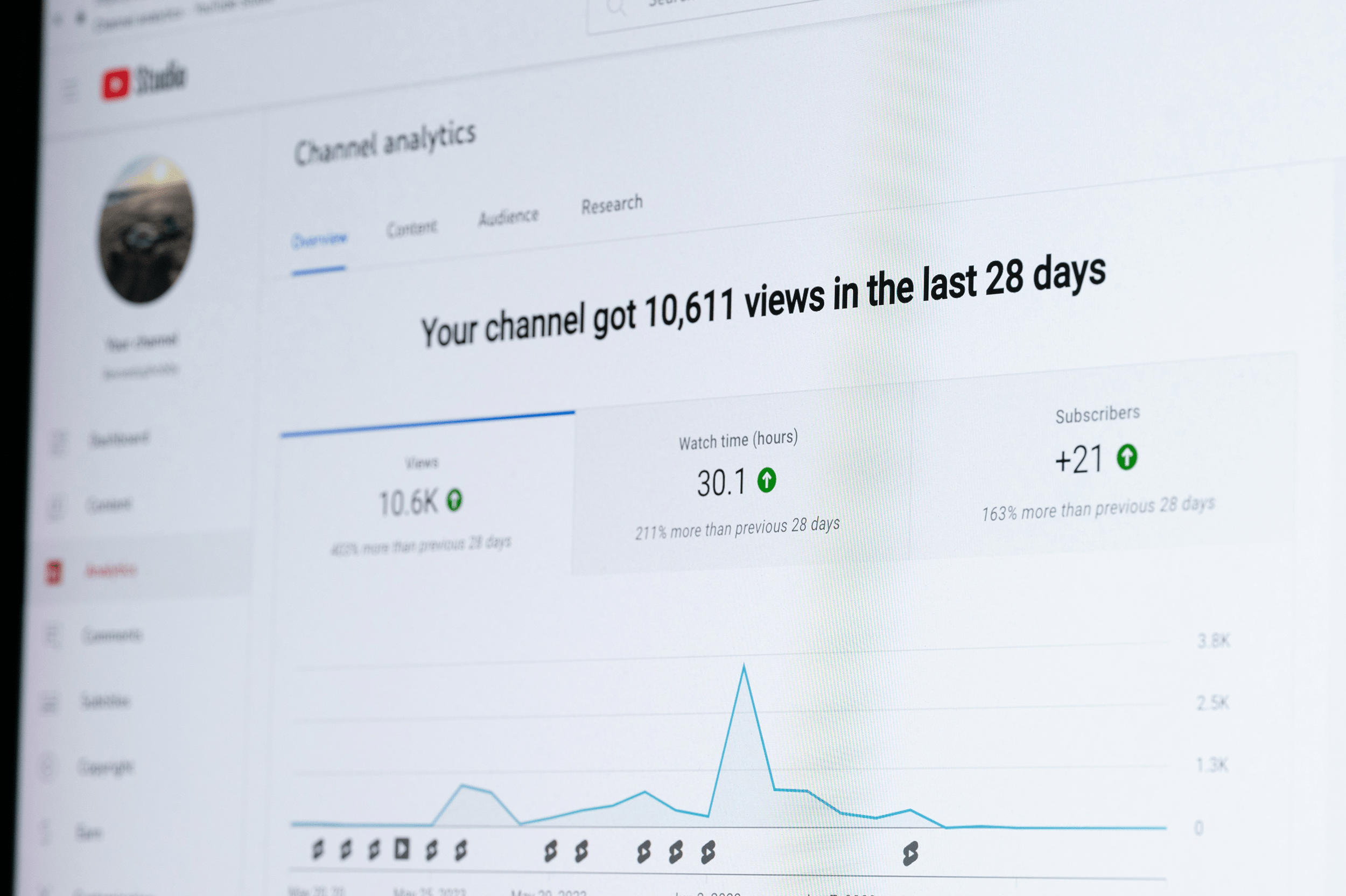Social media marketing is one of those fields you can never truly master: Trends shift. Algorithms are updated. Influence is fleeting. New features are introduced.
And then, as each small change flaps its butterfly wings, the effects extend to the entire social landscape. And soon, social user behavior adapts, too. Buyer habits evolve. Yesterday’s strategy is ineffective today.
That’s why up-to-date social media statistics are so important: They affect tomorrow’s strategies. They help you predict the day-after-tomorrow’s trends. And so, we’ve sourced this list from the latest studies, surveys, and analysis – almost exclusively pulled from 2019 and 2018. So, you know you’re current on what matters most, not only for today but also for tomorrow.
Here are 50 important social media statistics, plus their takeaways, that every marketer should know in 2019.
- General social media statistics
- Social channel statistics
- User behavior statistics
- Influencer marketing statistics
- Social engagement statistics
- Social video statistics
General social media statistics
The world has gone social. Overwhelmingly so. We’ll let the numbers speak for themselves.
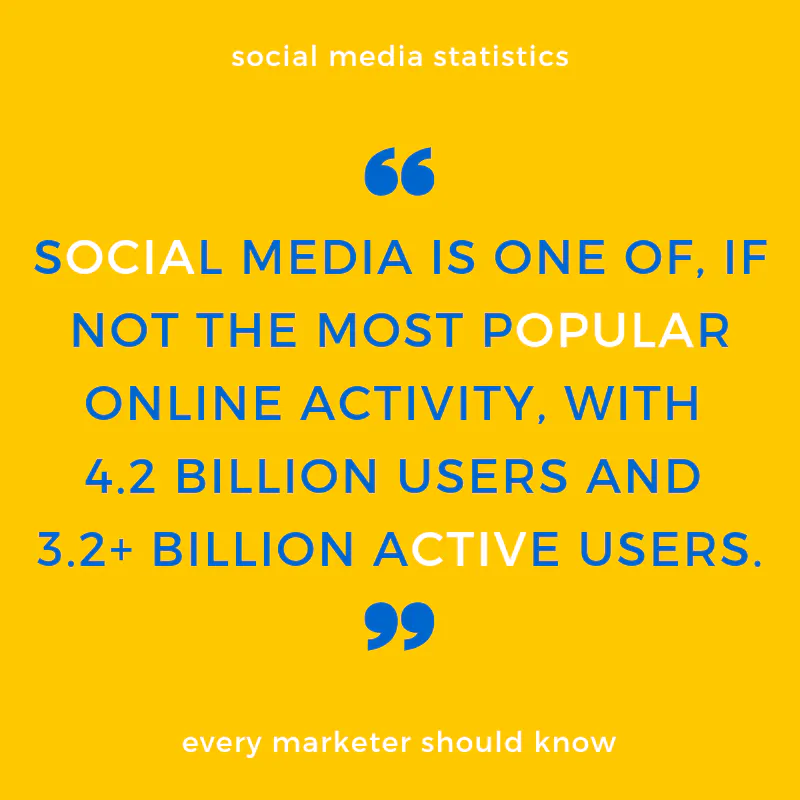
1. 3.2 billion people use social media, every day. Social media is one of, if not the most popular online activity, with 4.2 billion users and 3.2+ billion active users a day, much in thanks to the rise of mobile apps. Compare that to the world’s total population of 7.7 billion, and it’s clear – a huge percentage of your future customers, clients, and clientele live, play, and even work online.
2. If your consumers are in the United States, there’s an excellent chance you can reach them via social. In the USA alone, an estimated 7 out of every 10 people has at least one social media account. If you’re not catching them there, another brand definitely will.
3. Active social media users are promiscuous. No, not that kind of promiscuous – promiscuous in their social media loyalties! On average, internet users who have social media accounts report an average 7.6 social media accounts each.
4. If you operate a global brand, look east. Farther east – to Asia. As of 2019, almost half of all Internet users are in Asia. Half! That’s a huge market. And, in the Asian market, Facebook mobile and Instagram mobile are the most popular apps within Asia. Be there or be square.
5. And, despite the already overwhelming use of social media, new users are logging on every day. It’s mind-boggling, but an average of 11 new users per second (!) use social media for the very first time. Yes, we said every second. That’s 86,400 new users a day.
Social channel statistics
There are over 20 popular social channels today. Twenty. No one marketer can properly focus his or her efforts on all 20. So, which deserve your focus? Which can go on the back burner? The statistics can help inform your marketing decisions.
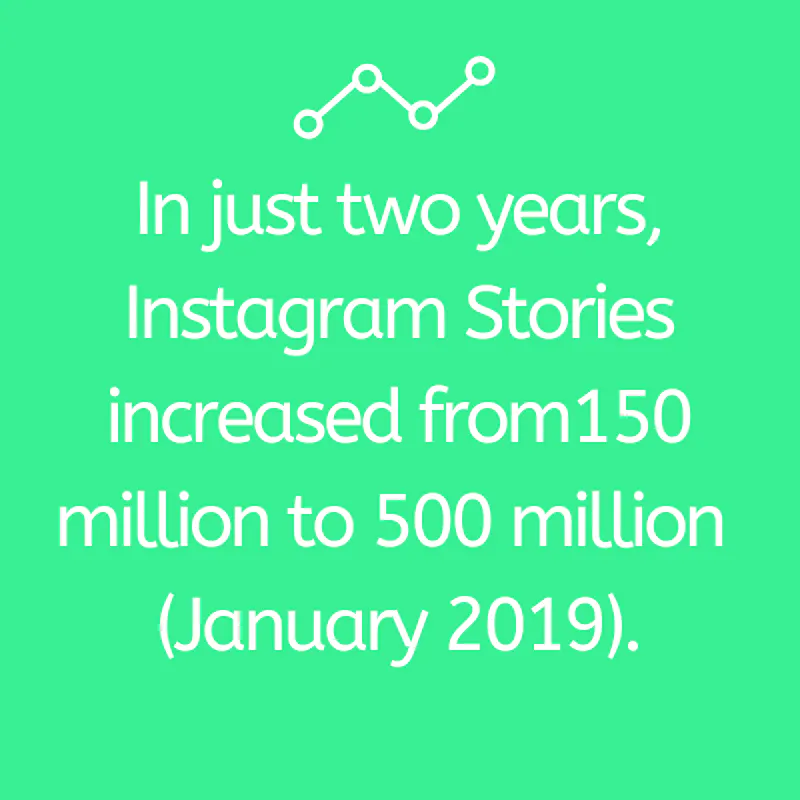
6. Facebook leads the market. By far. Still. Over the years, other social networks have grown up but Facebook – the first network to pass the one-billion active user mark (circa 2012), not so coincidentally – still reigns. About two-thirds of U.S. adults (officially, 68%) are Facebook users. And, it’s not just the United States; the platform reports 2.32 billion active monthly users.
7. Talk about marketing power! YouTube is the second-most visited website in the world, while Facebook takes the coveted third slot. Websites, not social networks. In the world. Only Google (#1) comes in ahead.
8. Instagram Stories are a rising star of social media. If you’re looking toward new avenues in 2019, Instagram Stories should definitely be on your radar. Want to know something mind-blowing? In just two years, Instagram Stories increased from 150 million to 500 million (January 2019). And that means, your brand needs to embrace the creative freedom of the format, and connect with your audience on a storytelling level.
9. Marketers spend the vast (VAST) majority of their efforts + money on Instagram. Big surprise there, right? But, ‘tis true – more than two-thirds of marketers report that they will spend most of their 2019 marketing budget on Instagram. That’s a whopping 6x the 11% they’ll spend on YouTube, the second-most popular spending channel.
10. And the award for social dark horse goes to… Pinterest! Many social media marketers overlook the power of Pinterest but, from a global standpoint, this is the fastest-growing social platform. In fact, 80+ percent of new Pinterest users live outside the U.S.
11. Do not discount the importance of Twitter marketing. 88% of social advertisers put effort into Twitter, resulting in the platform earning a total $665 million in revenue during the first quarter of 2018. (For the record, that’s a 21% increase from 2017.) What’s more, $575 millions of Twitter’s revenue came from ads – another 21% increase.
12. On average, Twitter users report a higher average education than users from any other social network. A minimum 32% of Twitter users have a college degree, while a mere 18% report that they hold a high school degree. Those are important statistics, if you know your audience.
13. And while we’re on the subject of Twitter, this is the channel to reach Millennials. Because, when it comes to Twitter, the single largest age group among users belongs to Millennials, with the younger Generation Z following closely at their heels. (Give ‘em a few years, and they’ll likely overtake their big siblings.)
14. People love to share, share, share, share, share, share, SHARE! If you haven’t enabled one-click sharing and messaging, you’re missing out big-time. Just consider this: Facebook Messenger and WhatsApp handle 60 billion messages a day. 60 billion messages a day. That’s nearly 8 messages for every person in the world. You are in desperate need of social share buttons.
User behavior statistics
One of the first steps toward better social media marketing, is knowing your audience. Who are they, what do they care about, and where do they socialize online? Statistics point the way.
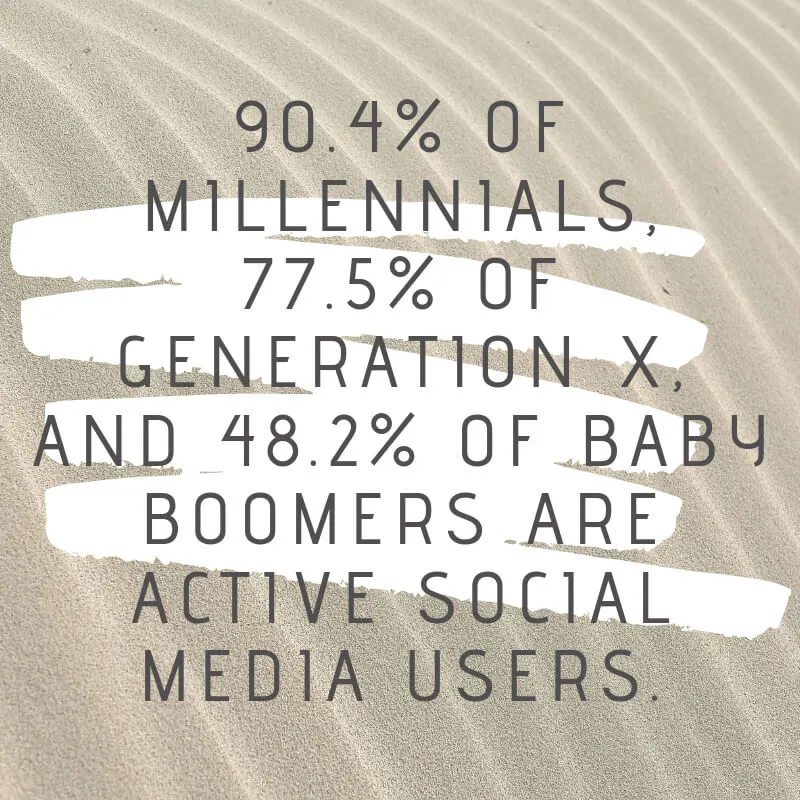
15. Millennials are the most active social media users, but don’t count out Gen X or even the Baby Boomers. Yeah, we said Baby Boomers. As of 2019, a reported 90.4% of Millennials, 77.5% of Generation X, and 48.2% of Baby Boomers are active social media users. Millennials take top billing, thanks to their familiarity with smartphones; Gen X are more likely to access social via tablet; and Baby Boomers have slowly adopted social media to seriously bridge the technology gap. Read it again: nearly half of all Baby Boomers are active social media users. If they’re you’re market, they’re also online.
16. In 2019, young adults are prolific users of social media. In fact, the largest age group on social media is the 18- to 29-year-old set. And, of these users, a reported 88% connect to social media every day. That’s a lot of people with a lot of activity. Make sure you’re creating content that resonates with them.
17. Speaking of, think older users don’t engage with brands online? Myth, debunked. A recent study shows that people aged 55-64 are more than twice as likely to engage with your social presence, than are people 28 and younger. That’s right – you’re 2x as likely to hear from someone 55+, than from a 25-year-old.
18. Users are addicted to social. Too bold a statement? Well, consider that on average, people use social media for a whopping 2 hours and 22 minutes PER DAY. Per day! That’s more than 5% of their day – or 8.5% of waking hours. Social media is integrated into daily life, whether it’s the photo someone posts of a perfect meal or the family update she posts to Facebook. Bottom line: You have 82 minutes, every day, to post content that will grab your audience’s attention.
19. Survey says, ads are becoming more relevant. 57% of Millennials, 45% of Gen Z, and 41% of Gen X-ers report that the social ads they see are more relevant today, than they were yesterday. (Only 27% of Baby Boomers agree.) Even more important than the statistic alone, relevant ads are less irritating to the average Joe. After all, would you rather see an ad something you have no interest in, or an ad about something of interest?
Social media marketing statistics
Social media marketing is your bread and butter. You’re invested in doing the best job you can, and these statistics will show you which networks deserve your intense focus, and which can be avoided.
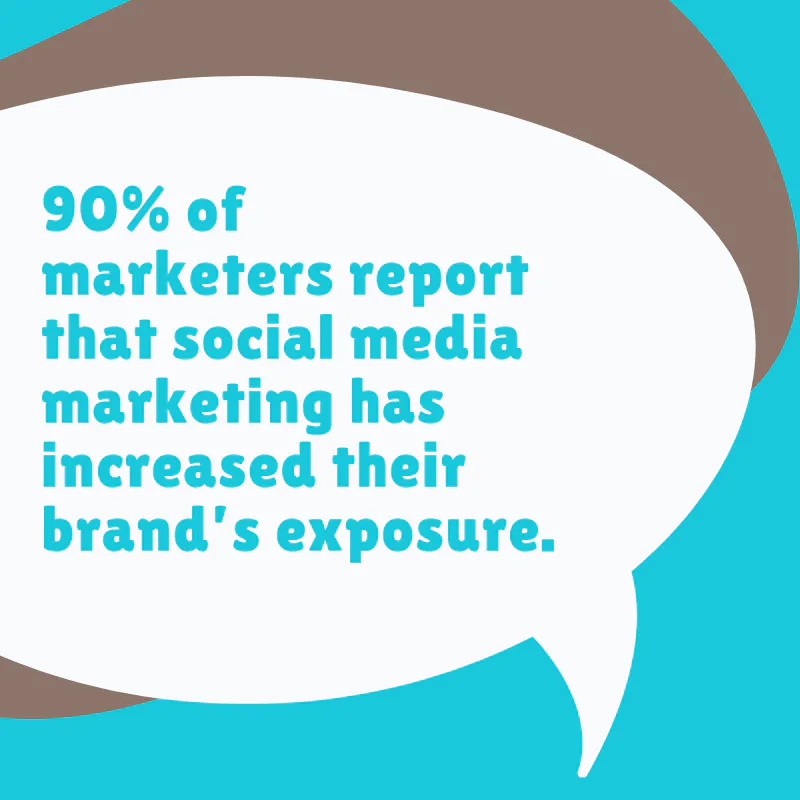
20. This is not a one-marketer show; you probably need a team to master your social media efforts. And, about 78% of businesses have taken note – they’re hired dedicated teams to manage their social media accounts and advertising.
21. You can no longer avoid it: Social media marketing ranges from “somewhat effective” to “very effective” for business. 73% of marketers aren’t wrong but, if you’re not actively marketing via social media, you probably are. Your marketing needs a social aspect, whether you’re paying to extend your post reach or engaging in the growing trend of influencer marketing.
22. You’re not living your best marketing life, unless you’re making efforts on social. An impressive 90% of marketers report that their social media marketing has increased their brand’s exposure.
23. In 2019, you’re almost required to invest some marketing $bucks in social media. Even though $40 billion in social media advertising sounds like big bucks, they’re big bucks well spent: 75% of marketers report that their paid and organic social efforts led to increased traffic. It’s not just what you do on social, but what social does for you.
24. Social media isn’t just for the big-spenders, either. Even if you’re a tiny one-person business, you should know – 81% of all small and medium businesses use, interact, and advertise via at least one social platform. And, if you’re like 91% of retail brands, you’ll want to bump that number to at least two social channels.
25. If you’re looking to get more customers, social ads offer one of your best chances. Non-customers – or, shall we say? not-yet customers – are three-times more likely to visit you via social media ads, than are existing customers.
Influencer marketing statistics
Influencer marketing made its rise about five years ago, growing from a secondary marketing method to one of the most important tactics today – and into a $5-10 billion-dollar industry. And yet, many marketers still ask: Does influencer marketing actually work? Here’s what the statistics have to say:
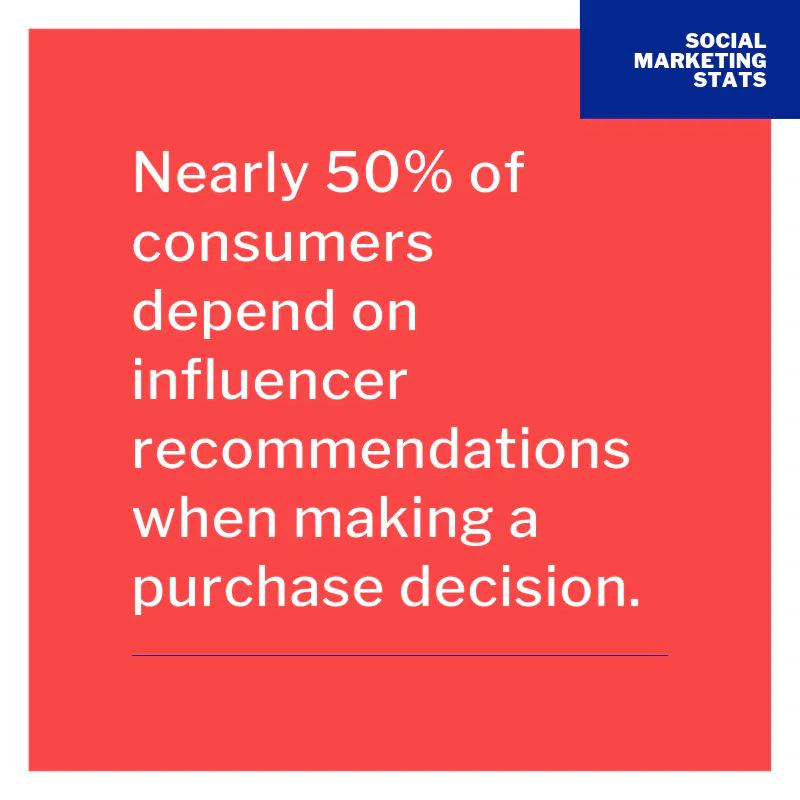
26. Consumers rely on influencer recommendations. REALLY rely on them. Believe it or not, nearly 50% of consumers depend on influencer recommendations when making a purchase decision. That’s half of your potential market! The reasoning: They trust influencers. They feel confident in what influencers tell them. So, connect with influencers (and do it authentically).
27. Influencer marketing budgets are on the rise. Is yours?Almost two-thirds of marketers report that their influencer marketing budgets will increase in 2019, versus just 39% of marketers reporting the same in 2018. In other words, influencer marketing is on the rise, not just among consumers but (unsurprisingly), also among marketers.
28. Wondering how much to spend? $10,000 should do it. Well, or $1,000. Or $500,000. Yes, influencer marketing budgets sweep from a reported $1,000 to $500,000 per year: 19% of marketers spend $1,000-$10,000 annually and 18% spend $100,000-$500,000 a year. A small but significant 7% report they’ll spend $1+ million on influencer marketing in 2019.
29. You should consider spending half of your marketing budget on influencers this year. Startling, but true – 17% of marketers report that they’ll dedicate half of their total marketing budget to influencer marketing in 2019. And yes, while it’s just 17% (for now), this shift highlights how important influencer marketing has become, especially for influencer industries like fashion and beauty, travel and lifestyle, ecommerce and gaming.
30. Worried about ROI? Influencer marketing can deliver solid returns. While some aspects of marketing are hard to track, 89% of marketers say that influencer marketing ROI is better or equal to other marketing channels.
31. Looking to make greater and more meaningful impact (with the help of influencers)? Head on over to Instagram. Instagram claims more than 1 billion users but, what’s even more significant, is that marketers rank the channel as the most important and significant for influencer marketing, thanks its photo medium, high activity from influencers (and micro-influencers), and direct line to niche markets. Bonus: All those micro-influencers are a lot more accessible to the average brand with a smaller budget.
32. Want to influence with reach? Instagram Stories are the second-most popular format for influencer marketing. Instagram Stories reach over 500 million Instagram users every day – it has grown an incredible 15x faster than feeds of any kind – and are highly navigable; users also report that they feel more authentic and “less staged,” thus boosting their efficacy.
33. Don’t want to dig yourself an influencer money pit? Then, maybe skip the Twitch livestream. Among marketers in 2019, Twitch livestream is considered the least effective influencer marketing channel – even though it pulls 15+ million daily active users. The only caveat: If you’re in the gaming industry, this statistic is skewed in your favor: the majority of Twitch’s 15 million users are also gamers.
34. Steer clear of Snapchat. Or – maybe? – steer straight to it? Due to past limitations, Snapchat lost ground with influencers – and the marketers who sponsor influencer content. Instagram Stories now record twice as many daily active users as Snapchat, placing Snapchat directly at the bottom of most influencer marketing budgets. That said, if you’re looking to do something different, don’t begrudge yourself a closer look at Snapchat. It’s a longshot but someday, at some point, a savvy marketer will hit on Snapchat gold. It could be you!
35. Looking to get started with influencer marketing? Then, welcome to Instagram. The absolute most-used format for influencer marketing is the photo-centered Instagram, which 78% of marketers say is their #1 choice for this rising marketing channel. That’s due, in part, to the relatively low cost-barrier-to-enter, thanks to Instagram’s photo+caption format – a more economical alternative to long-form video, written content, and other mediums.
Social engagement statistics
Many marketers live and die by their engagement statistics: How effective are you at interacting with your audience, inviting them to interact with you, and encouraging shares? When engagement’s on your mind, you should also turn your eye to effectiveness – how can you improve your marketing efforts, in order to increase engagement?
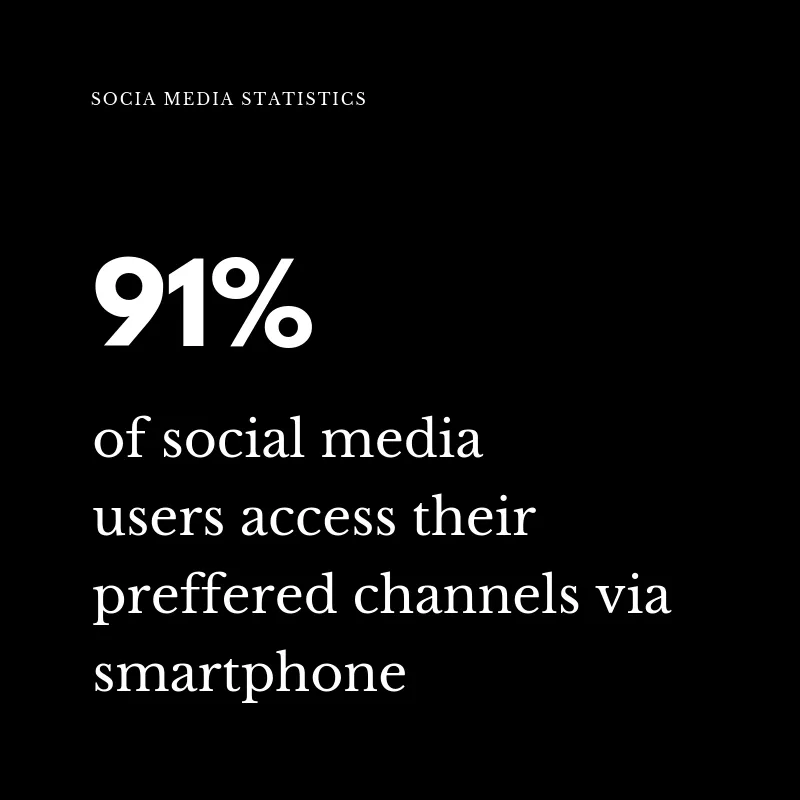
36. You’re not doing social, if you’re not doing social for smartphones. It’s not enough to just “do social;” today, your social media efforts must be optimized for smartphone consumption. That’s because an average 91% of social media users access mobile via their smartphones and a jaw-dropping 80% of time spent on social media, is accessed via mobile platforms.
37. Your customers are researching your business online. That’s right – an estimated 54% of users research products and services via social media. They’re perusing your reviews (or lack thereof); they’re searching out recommendations (and the opposite). And that means, you need to enable social media reviews. You need to enable social media recommendations. And, when you get a bad one, respond to it – professionally.
38. Make people happy, and they’ll become your brand ambassadors. If you’ve ever feared that word-of-mouth was going the way of the landline, take heart – word-of-social is here to save the day. A recent study shows that an incredible 71% of consumers who have a positive experience with your brands, are then likely to recommend you to their friends, family, and acquaintances. Throw your efforts into building happy customers, and watch that customer base grow.
39. Think Twitter’s a mostly-text kind of channel? Well, you’d be 10x wrong. It should come as no surprise that Twitter users also like to shake it up a bit: Tweets with video report 10x more engagement than your standard photo or text-only tweet. What’s more, Promoted Tweets with video save 50% on cost-per-engagement.
40. There’s no better way to market to Gen Z and Millennials, than with social media. That’s because a reported 50% of Gen Z and 42% of Millennials say that social media is the most relevant advertising channel (overall, inclusive of all types of marketing) in their lives.
41. Customer service and customer relations are taking to social media. In fact, 48% of Americans say they have interacted with brands and businesses through social media. If you’re not on their channels, or if you’re not prepared to respond quickly, you’re missing out.
42. Social media is the right channel to grow your fan base and boost loyalty. Roughly 63% of social media marketers say that social media is useful – and in some cases – ideal for building loyal fans who interact, share, and otherwise engage.
43. If you’re launching or promoting a new product, Instagram is a great place to start. Not only is Instagram a favorite network among marketers, but 60% of social media users learn about new products first on Instagram. Start arranging that photo shoot, stat!
44. Make it easy and you’ll get more takers. If you sell products online, and if you promote those products via social media, be sure that you make payment as easy as possible. A reported 49% of social media users say they’d be more likely to make a purchase via social media, if easy and secure payment systems (ex. Amazon Pay) are enabled.
Social video statistics
Video is king. ← We could stop right there, but we won’t. We’ll also say that, while video is king, it’s only king when done well. And, with a medium as time- and resource-intense as video creation, you’ll want to make sure you’re funneling your efforts into well-done video.
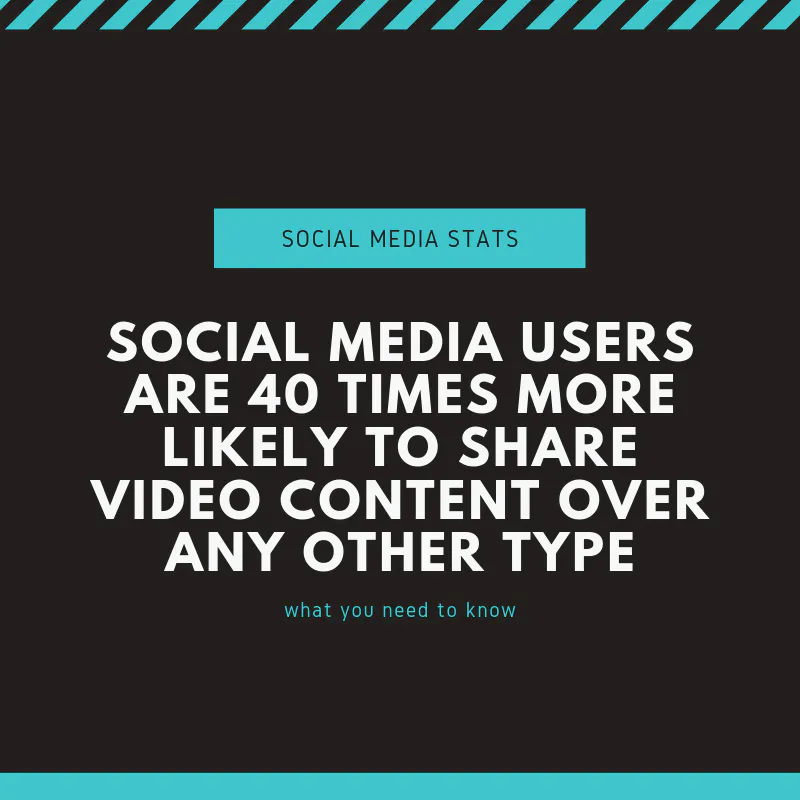
45. If you want to encourage shares, then you must create video content. When you consider that social media users are 40 times more likely to share video content over any other type, then it’s clear: a good chunk of your marketing budget and time should be dedicated to creating video that users will want to share.
46. But, video content is so prolific, you brand must be spectacular to cut through the noise. It’s almost impossible to fathom, but users upload more video content to social media in just 30 days, than U.S. television networks created in the the last 30 years combined. If you want to stand out (and you need to stand out), then you need to find a way to connect with your audience – even when they’re bombarded by hundreds of other competing videos.
47. Your video is nearly worthless, if it’s not captioned. Here’s a fun fact: 85% of Facebook users mute their video. That means, if your videos aren’t captioned (or very visually interesting, no captions required!), then most of that 85% will keep on scrolling.
48. If you’re already doing well on Facebook, you could be doing even better. The key to success: video. Video performs better than any other type of content on Facebook. (Just remember to add captions!)
49. Does your audience live on LinkedIn? Then, chances are good that they crave video content. In fact, LinkedIn users are 20x more likely to share video content, than they are to share or post about any other kind of content.
50. If you’re looking to convert Pinterest users to customers, then you should be producing more video. You can more than double your chances with video: Pinterest users are 2.6x more likely to make a purchase after they’ve viewed branded video content.
Speaking of Pinterest, one of the best (and easiest!) ways to grow your Pinterest following is with the easy-to-install Pinterest follow button. You can install it in just minutes to start growing your Pinterest following today!


